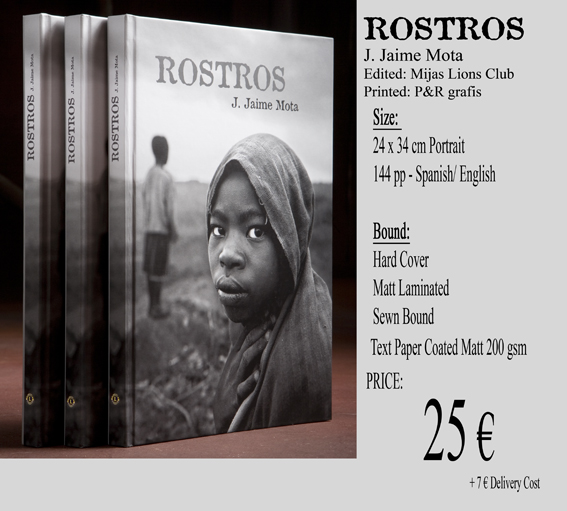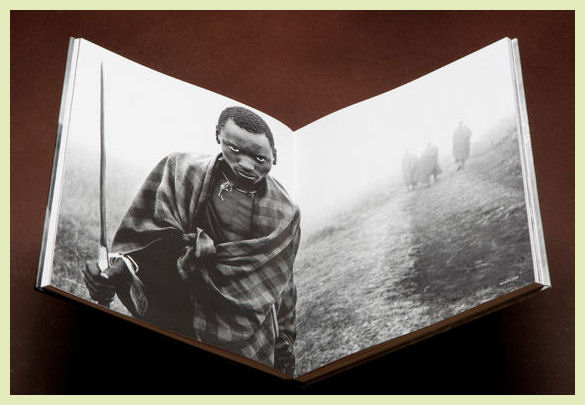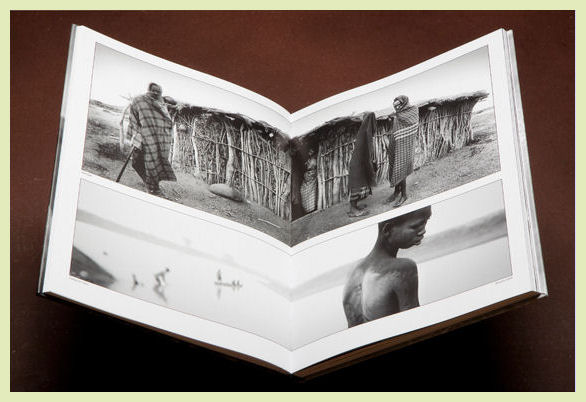
One of the purposes of the Lions Clubs is to “To Take an active interest in the civic, cultural, social and moral welfare of the community”. Following this objective, the Lions Club of Mijas has already published three books and a catalogue of artists of Mijas. We have decided to launch ourselves into this project, which is the most important we have carried out up to date. We are fortunate to have in Mijas one of the most prestigious photographers of Spain who is also a friend and a member of the Lions Club of Mijas.
I do not think anybody could doubt the artistic quality of Jesus, the prizes he has received throughout his career as a photographer demonstrates this. Therefore, I will not make any comments on this. What may not be so known about him, is the human and solidary aspect that characterizes him, that is probably what has created my relation of friendship with Jesus.
The wish for returning to the society part of what the society has given us, in favour of the least fortunate, has forged the generous and solidary character of this great artist. He has always wanted to do something for others and has found in photography the way to help the underprivileged.
 The
first great humanitarian project that he carried out was the reconstruction
of an orphanage in Tanzania together with his friend J. Luis García.
One year later, he travelled to Sri Lanka accompanied by journalists
Anna Smith and Franco Rey. They did a photographic article for our Association,
for the campaign " HELP US GIVE THEM A HOME " where he showed
the cruellest and most painful side of the devastating tragedy that
the Tsunami originated. In 2007, together with his friend Gabriel Brau,
they organized a supply of medicines to the most humble hospitals in
Ethiopia and finally had the constant concern of taking photographs
of blind people for the Campaign SightFirst II, which deals with the
eradication of curable blindness in the world.
The
first great humanitarian project that he carried out was the reconstruction
of an orphanage in Tanzania together with his friend J. Luis García.
One year later, he travelled to Sri Lanka accompanied by journalists
Anna Smith and Franco Rey. They did a photographic article for our Association,
for the campaign " HELP US GIVE THEM A HOME " where he showed
the cruellest and most painful side of the devastating tragedy that
the Tsunami originated. In 2007, together with his friend Gabriel Brau,
they organized a supply of medicines to the most humble hospitals in
Ethiopia and finally had the constant concern of taking photographs
of blind people for the Campaign SightFirst II, which deals with the
eradication of curable blindness in the world.
However, the most important objective of a book should be to leave a historical testimony for future generations of our history and of an unrepeatable period. This book, "ROSTROS", (which means faces) shows the reality of a changeable and different world. It is also important to say that all the profits gained from this book will be entirely applied to the humanitarian help of the Lions Club. This is Jesus' wish.
The pictures he has obtained are not only photographs; they are expressions and feelings of the soul, which give an almost surrealistic extension of a very hard daily life that at the same time is full of beauty. In every picture you can sense a murmur, hear the laughter of a child, or the weeping of an elder. It is the expressiveness in its purest condition; they are sensations of other worlds. You can breathe the heat of the desert or feel the breeze of the sea.
 What
Jesus grasps is not a portrait, it’s much more ......
What
Jesus grasps is not a portrait, it’s much more ......
Luis Domínguez Calderón
PRESENTATION
Today we have to talk about photography. Of the photography that I like so much because it is done from the heart, from which feelings arise and which shows us the soul of the protagonists, photography that is art because it was conceived and carried out this way, photography that when I contemplate it I get excited because it talks to me.
I t
is necessary to go slowly through each of the pictures of this book
to be able to submerge oneself in the worlds that the author proposes
us. Those worlds that throughout the years he has known how to discover
and capture throughout many trips and that today finally, he can share
with all of us.
t
is necessary to go slowly through each of the pictures of this book
to be able to submerge oneself in the worlds that the author proposes
us. Those worlds that throughout the years he has known how to discover
and capture throughout many trips and that today finally, he can share
with all of us.
Throughout these pages, I have revived the poverty of Africa, recalling
how hard life is in any of their tribes, and I have felt the pain of
Asia, by looking at the sadness hidden behind each of the faces crushed
by the course of time; but I have also found hope again by contemplating
the children of the African schools, and have been able to discover
the soul of a village, with the complicity expressions of their people.
In Jesus' photographs, every thing is in its place,
no element stays at random, and nothing is due to coincidence. His work
is masterfully sculptured by the light, the light that he looks for
and that is so necessary. That leads him to travel through some of the
most inhospitable places on Earth, with the only intention of taking
that photo that, with the power and the freshness that he alone can
stamp, some day will turn into a piece of art.
Today we have to talk about photography, but also about the photographer.
Not to praise his mastery in the trade of painting with light, which
he has, but to discover his most human facet; because nothing of what
you have in your hands would have been possible, without the humanity
of its author. This humanity which has involved him with solidary projects
in each of his trips, from helping Masai tribes in Tanzania, up to supplying
medicines to the villages of Ethiopia, (in which I took part) or the
cooperation with those harmed by the Asian Tsunami.
The empathy he possesses is the innate condition that allows him to approach the protagonists of his stories, to show them as they are and as they live, to remind us that in our world there are also other parallel worlds existing.
Every morning, when I start work at my study, I contemplate the photograph that he gave me many years ago. It’s the one titled " Masai Warrior's Foot ", and is an immense photograph, which manages to transport me, in spite of the years, to those fantastic worlds that I like so much; it is no doubt a piece of art.
But what I most admire and still today thrills me when I read it, is the small dedication that he wrote: " To my friend Gabriel, so that photography continues being a conductive thread of a great friendship ". Today this friendship has grown and has got stronger with time, because for many of us photography is undoubtedly a great way of making friends; something he knows a lot about.
Today in name of this friendship, I hope that you never stop showing us your worlds, your fantasies, your feelings or your emotions, and wish this book the best of all lights.
Gabriel Brau Gelabert.
MIJAS CARACTERES
This is the first important work that Jesus has carried out within his prolific professional career. In mid 1992 he started gathering a series of photographs with those people who, due to their professions, have occupied an important part of the history of Mijas and of the memory of their inhabitants. Completing the execution of this interesting project in the year 1995.
The series of photographs here represented show people who revive memories, the nostalgia of a transition period that begins with the difficulties and absolute poverty of an Andalusian village, up to the reality of the social welfare that we enjoy nowadays. These people in the 50s and 60s supposed a qualitative advance of the lifestyle in a village, and the need to develop a modern society. From having a doctor, a postman, or an electrician always available. But also reflects an important change regarding the relationship of these people with the inhabitants. These were times where the links that were established between these professionals and the village were much deeper and personalized. There was only one pharmacist, who undoubtedly knew at her fingertips all her clients, a postman who could deliver the mail with his eyes closed, a doctor whose most valuable storage of reports was just a simple file cabinet, or the midwife, available twenty-four hours a day.
This is what Jesus has reflected here, a social transition that begins with a diverse group of people, singular, intimate, and who are directly responsible of the evolution and changes of a society. In short, a magnificent work that recovers a part of the historical memory of a forgotten period. But undoubtedly, it is important to emphasize that a today would not exist without counting on the existence of these people and their valuable work. Also, it is worth mentioning about Jesus his continuous concern for perpetuating in his photographs the indelible recollection of the history of his village, Mijas's history.
AFRICA
Immediately after being awarded the “El País semanal” prize in 1995, Jesús travelled for the first time to the African continent. This would be the beginning of a long adventure, where from the first moment he feels that something envelops him, hypnotizes him and, motivates him to stay there. Undoubtedly, due to these sensations he falls in love with Africa, with its people, with its culture, with the landscape, with the heat, with the cold and with the strange customs of every Ethnos. He travelled year after year visiting remote areas, isolated from the usual tourist routes, in search of the most primitive Ethnos such as the Surma, Karo and Dhasanech of Ethiopia, the Masais, Datoga, and Hatsas of Tanzania, the Mandinga, Wolof and Jola of Gambia, the Bozo, and Dogón of Mali.
He realizes the photographic and documentary potential that he is obtaining in each trip and of the incredible artistic possibilities that this continent has. This will push him to catch faultless snapshots more brilliant than can be imagined. Jesus' photographs have life. Far from being mere representations in paper, his work turns out to be a window full of substance that reflects, without having to use words, a rich and extensive description of the most diverse cultures. The experience lived in Africa motivates him to continue travelling through this continent, continent that has enchanted him from the very first moment.
For Jesus to travel through Africa is like a cure of the spirit and mind. Since then he has learned to value aspects that before were happening to him completely unnoticed, and has changed his concept of seeing life in favour of a deeper reflection about the shortages and difficulties that certain villages experience in comparison to the excesses and materialisms that involve the culture of the Old European Continent and, particularly, Spain.
ASIA
His first contact with Asia was to the North of Thailand in the year 1998, where he visited the indigenous establishments of the area. Since then he has returned on several occasions to this continent attracted by the Asian spirit, fascinated by the amiability and hospitality of India, the overcoming strength of the people of Sri Lanka, and the eternal smile of Thailand.
India is one of the countries that has attracted Jesus the most, being the one that he has visited the most in Asia, crossing the South from Tamil Nadu to Kerala, and the North from Rajasthan to Uttar Pradesh, visiting the Holy cities of Benares, Alahabad and Puskar in search of the "Sadhus" (Holy men who dedicate most of their time to meditation), with which he tries to spend as much time as possible to be able to catch the sincere look that each one of us has inside. We could say that not only has he photographed India but he has also managed to catch the hidden meaning, the magic essence and the peculiar character of a thousand-year-old village, full of legends and mysteries.
Jesus neither sleeps in big hotels, nor considers his trips as a holiday. He stays in simple lodgings with people of the country where the contact and the chats supply him with one of the most important routes of veracious information. Jesus' trips can be conceived as a real adventure in every sense. Jesus adapts himself into the environments that he visits to reflect in his photographs a culture in its purest condition, without altering the originality of the situations gathered by his camera. This is the reason why he has been able to give life to his pictures, reflecting the soul of so distant lands and of people not so known to us.
With these trips, he manages to express the sweetness and the enchantment of the East perfectly catching that infinite expression with such a realistic feeling of peace that his photos seem to speak and move. We could even affirm that we can see the karma of their people, an inexplicable concept in the West, but very present in these types of countries.
SCHOOLS
In his several trips throughout the world, Jesus discovers the possibility of taking photos in schools and starts developing perseverance in his photographic trajectory. Whenever he travels, he tries to visit schools and to do an article of those places. It is these trips that awake an altruistic zeal in him to do something for the least lucky, the disadvantaged ones, those that the system has deprived of the basic goods.
To see the difference between the western world and the extreme needs of these schools, have an affect on him, and it is this sensibility that will make him travel provided with school materials to cover the shortages of these centres, which he visits with the desire to give testimony of an unheard-of reality for the eyes of the western people. However, at the same time his photographs gather unique pictures that reflect some severity, which collides with the vision of our western schools that have been liberated for years from this type of treatment.
The photos are astonishingly pure where the expressiveness of the children’s faces, their innocence and the limited resources that they have to develop their education are extremely shocking for our concept of education, and in short with our way of life. The final result are a series of truly spectacular photos, where any attentive observer will discover small school scenes that hide behind a whole cultural universe that opens us the doors to a different world. An idea that reinforces the concept of North - South.
SOLIDARY PHOTOS
It is this chapter, the one that can most probably best summarize the character of Jesus, a man with a " Lion's Heart ". In all his trips, his desire to help is clear. Jesus always remains alert detecting any existing shortages in the places that he visits. It is normal to see him loaded with medicines and projects of help. His first great humanitarian task was the improvement of an orphanage in Tanzania. Thanks to the participation of the village of Mijas, the Lions Clubs of Spain and our International Foundation, the reconstruction of the orphanage was carried out. As you will be able to see in the photographs, the situation was dramatic. Thanks to the attainment of these types of programs the idea that it is possible to improve the living conditions of the least lucky is reinforced. For Jesus, this anxiety to act is rewarded when, once the purpose has been obtained, he discovers the personal satisfaction of having collaborated with his small contribution in the construction of a less unfair world for them.
After the disaster of the Tsunami in Southeast Asia, I suggested Jesus to go and take some photos for our Association. He did not hesitate an instant to do so. His photos exhaustively describe how in some cases nature fiercely thumps devastating any area of existing life. His pictures reflect faces of desperation, shocked by the tragedy, involved by the latent sadness of the loss of their loved ones. In short, they represent the consequences of a natural disaster without precedents. In the same way, due to the quality of the material carried out, Jesus' photographs have been published in hundreds of magazines all over the world.
Finally, we must mention that the major program of the Lions Clubs is the eradication of the curable blindness in the world. Jesus has done the most important labour in this respect, visiting hospitals financed by us in remote areas of the world, and doing some magnificent articles that have been published on the front page of important magazines worldwide. An incredible labour that discovers not only a great photography professional, but also a " great person " who also uses his own means to cooperate in the improvement of the most disadvantaged. Jesus is the expression of a man of brilliant ideas and surprising balance, as well as a man whose social commitment does not have barriers. In short, Jesus could be described as a " four by four driver of life ".